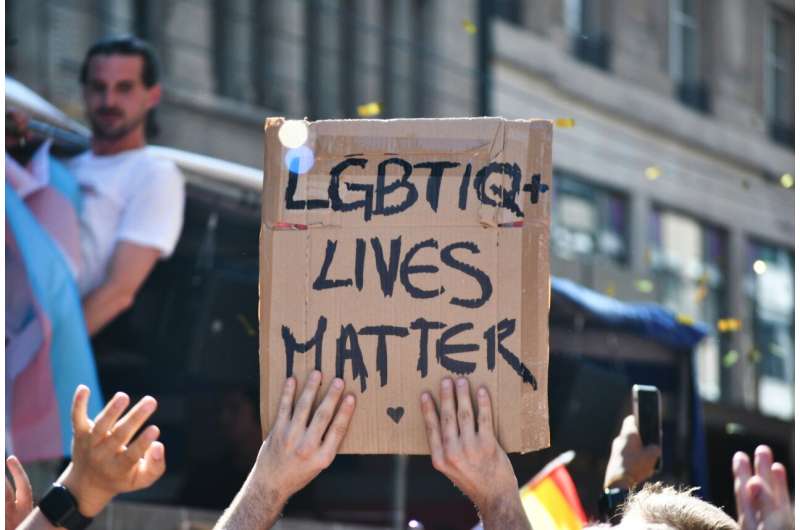This article has been reviewed according to Science X's editorial process and policies. Editors have highlighted the following attributes while ensuring the content's credibility:
fact-checked
peer-reviewed publication
trusted source
proofread
Among cancer survivors, LGBTQ+ individuals report higher prevalence of chronic health conditions, disabilities

Cancer survivors who identify as lesbian, gay, bisexual, transgender, queer, or anything other than straight and cisgender (LGBTQ+) experience more chronic health conditions, disabilities, and other physical and cognitive limitations than non-LGBTQ+ cancer survivors; however, the prevalence of most conditions was highest among transgender or gender non-conforming (TGNC) individuals.
Prior research
shows
Meanwhile, LGBTQ+ individuals, who represent about 7.1% of the U.S. population, have been found to face health disparities due to stigma and other social determinants of health. But few national samples that differentiate between cisgender and transgender identities have been used to study disparities among LGBTQ+ cancer survivors for chronic health conditions, according to Waters.
Austin R. Waters, MSPH, a doctoral candidate in health policy and management at the UNC Gillings School of Global Public Health in Chapel Hill, North Carolina and colleagues used data from the Behavioral Risk Factor Surveillance System (BRFSS), a phone survey system managed by the Centers for Disease Control and Prevention, collected in 2020, 2021, or 2022 from 23 states that administered questionnaires about sexual orientation and gender identity as well as cancer survivorship.
The findings are published in the journal Cancer Epidemiology, Biomarkers & Prevention.
Of 40,990 cancer survivors, 1,715 were LGBTQ+, including 638 lesbian or gay individuals, 551 bisexuals, and 458 who identified as another non-heterosexual sexual orientation, such as queer, pansexual, or asexual.
Of the 114 TGNC cancer survivors, 38 identified as transgender men, 43 as transgender women, and 33 as gender non-conforming. Overall, the LGBTQ+ cancer survivors were significantly more racially and ethnically diverse, had a lower household income, and were younger both at the time of the survey and at diagnosis of their cancer.
Participants were asked to reply "yes" or "no" if they were "ever told" they had chronic health conditions such as angina or heart disease, asthma, COPD, depressive disorder, kidney disease, stroke, or diabetes as well as disabilities and physical limitations such as hearing disability, vision disability, difficulty walking, difficulty dressing, or difficulty running errands, or cognitive limitations such as serious difficulty concentrating, remembering, or making decisions due to any physical, mental, or emotional condition.
Waters and colleagues compared results between LGBTQ+ and non-LGBTQ+ cancer survivors. They also broke the results down by examining TGNC and cisgender lesbian, gay, and bisexual (LGB) cancer survivors in comparison to non-LGBTQ+ cancer survivors and controlled for factors including age, race and ethnicity, smoking status, and education and household income.
When adjusted for age, race and ethnicity, smoking status, and education and household income, LGBTQ+ cancer survivors overall had higher odds ratios of reporting asthma, depressive disorder, kidney disease, stroke, diabetes, vision disabilities, cognitive limitations, difficulty walking, difficulty dressing, and difficulty running errands compared to non-LGBTQ+ cancer survivors.
The odds for TGNC cancer survivors, however, were substantially higher for most outcomes compared to non-TGNC survivors, with increased odds ranging from 2.34 to 6.03. The lone exception was depressive disorder. When adjusted for age, TGNC survivors also had a higher prevalence of most health conditions compared to LGB survivors except for depressive disorder as well as cognitive limitations.
"Transgender and gender non-conforming individuals are some of the most marginalized people in the LGBTQ+ community and are known to experience barriers to health care discrimination, more exclusion, more violence, and other factors than LGB individuals," Waters said.
"Our study highlights the challenges TGNC cancer survivors face and the need for TGNC individuals, as well as all other LGBTQ+ cancer survivors, to be prioritized in care across the continuum."
Waters said future studies will begin to explore how some of these outcomes, such as depression and cognitive limitations, interplay with financial well-being and the ability to work after cancer to identify ways to better support LGBTQ+ survivors throughout the care process.
"While interventions like LGBTQ+-specific prehabilitation or LGBTQ+ patient navigators may minimize some inequities, ultimately societal and policy changes such as non-discrimination laws, affordable housing, and affordable health care are needed to completely address such disparities," he said.
Limitations of this study include a smaller sample of LGBTQ+ individuals in BRFSS compared to national samples, which could indicate that participants were not comfortable disclosing information about sexual orientation or gender identity or that LGBTQ+ individuals were less likely to respond to BRFSS.
Additionally, cancer survivorship and sexual and gender identity survey modules are optional for states, which means the experiences of cancer survivors in states that did not elect to include this information are not reflected.
The cross-sectional design of the study could have also resulted in a cohort of healthier cancer survivors with less severe disease or treatment. Further, potential recall errors are possible due to the self-reported status of cancer and chronic conditions. The study also lacks information about cancer treatments and pack-years for smokers, which may have further explained the findings.
"Thinking about how LGBTQ+ cancer survivors' health compares to non-LGBTQ+ cancer survivors' is an important question because it begins to disentangle the driving forces behind inequities," Waters said.
"Notably, our analysis revealed that even when controlling for factors such as smoking status and income—factors known to be associated with poor health—LGBTQ+ cancer survivors continued to have higher odds of most chronic health conditions and other limitations."
More information: Chronic Health Conditions, Disability, and Physical and Cognitive Limitations Among LGBTQ+ Cancer Survivors, Cancer Epidemiology Biomarkers & Prevention (2024). DOI: 10.1158/1055-9965.EPI-24-0166
















